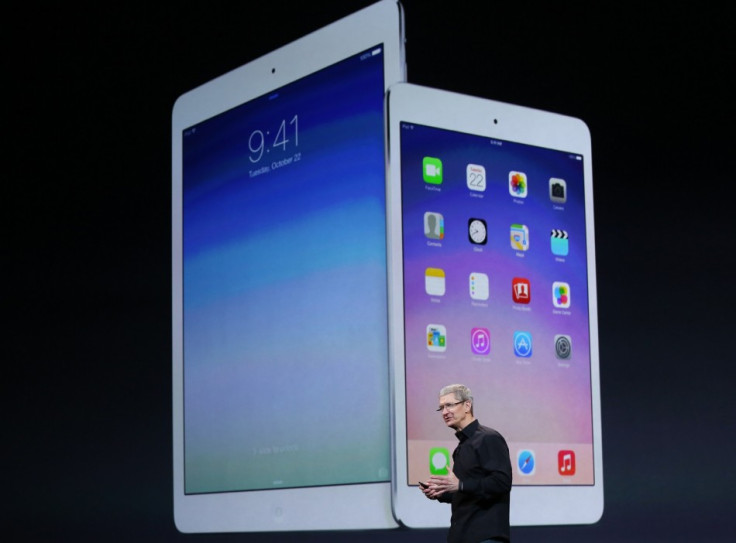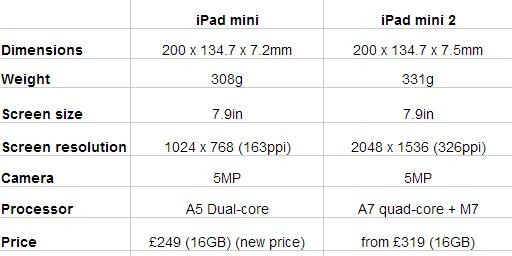iPad mini vs iPad mini 2 With Retina Display: Should I Upgrade?
When Apple launched the iPad mini a year ago its screen resolution was criticised almost immediately. Fans and critics alike berated Apple for not giving the mini a retina display, as used by the iPhone, full-size iPad and even some MacBooks.

It was a brave move by Apple to skimp on the extra pixels of a retina screen, and although the mini went on to sell like hot cakes, it never quite shrugged off its average display. Luckily for Apple, it took almost a year for the competition to bring retina-level resolutions to their 7in rivals - namely, the Amazon Kindle Fire HDX and the 2013 Google Nexus 7.
Now Apple has upped its game and brought the iPad mini to where it should have been a year ago - but is this enough to tempt buyers of the original to upgrade?

Hardware and Design
Visually - and before you turn the screen on - the iPad mini is almost identical to last year's original. It's almost exactly the same size and weight, and while eagle-eyed Apple fans might be able to tell this year's space grey from last year's black, only the white and champagne model looks different to the casual observer.
The rumour mills were convinced Apple would being its Touch ID fingerprint scanner to the iPad mini 2, having debuted on the iPhone 5s last month, but this wasn't to be. The iPad mini 2 also misses out on the widely rumoured gold colour option, seen on photos of components claimed to have leaked from Apple's manufacturers.
In adding a Retina display, the iPad mini 2 is 0.3mm thicker than the year-old original, and weighs 23g more - this was to be expected, as the full-size iPad gained thickness and weight when it upgraded to Retina back in 2012.
Display
Of course the biggest improvement here is the iPad mini's display. Resolution has been increased from 1024 x 768 to 2048 x 1536, while pixel density has gone up from 163 per inch to an impressive 326.
Although we're yet to get our hands on the mini 2, the doubling in pixels will make for much smoother, more rounded text, and sharper images. The original mini's screen wasn't a disaster, but it always felt fuzzy compared to the pin-sharp regular iPad; the retina screen here will no doubt fix this complaint.
Performance
Apple has replaced the original mini's dual-core A5 processor with the new 64-bit, quad-core A7 processor. The upgrade is significant for the mini, as it was presumed Apple would keep the smaller iPad one step behind the full-size version.
The new mini also gets Apple's new M7 co-processor, which constantly monitors the device's movement to help provide data for fitness applications from the likes of Nike. This is a great ideas for the iPhone 5s, but we're struggling to see the benefits for iPads, as we doubt any owner would want to go on a run carrying their tablet.
Battery life for the new mini remains the same as the old model, at 10 hours for Wi-Fi use and nine hours when using a 3G or 4G mobile internet connection on the cellular model.
Camera
The iPad mini's camera also remains unchanged, with both front and rear sensors the same as last year's original. That means a 5-megapixel rear camera and a 1.2-megapixel one at the front. Neither has a flash and neither benefit from the larger pixels as used by the iPhone 5s's rear camera.
Price
Apple has increased the price of the iPad mini from £269 to £319 for the 16GB model with Wi-Fi. Storage options remain unchanged at 16, 32, 64 and 128GB - with prices ranging from £319 to £559. Buyers who want to add 3G / 4G connectivity to their iPad mini 2 will need to add an extra £100 to each of these prices.
Meanwhile, Apple is continuing to see the original mini as a 16GB model for £249; a cellular version costs £349.
Should I Upgrade?
When we thought the new iPad mini would get a Retina display, A7 processor, Touch ID fingerprint scanner and new colour options, we thought an upgrade would be worth it - but now we're not so sure.
For some, the Retina screen will make the upgrade more than worth it - even after the £50 premium over last year's model - but other believed the mini should have had Retina from the start, and may question Apple's reluctance to bring Touch ID to more than a single device.
It's a shame that Apple felt the need to up the price of the mini, especially considering how well it has sold over the last 12 months, and while the Retina display will no doubt look incredible, the extra price and weight might put some buyers off.
Of course, the Apple Faithful will update no matter what, but with much more affordable competition from Amazon, Google and others, the new iPad mini makes us feel like Apple has held back more than it should have.
Read More:
© Copyright IBTimes 2025. All rights reserved.






















